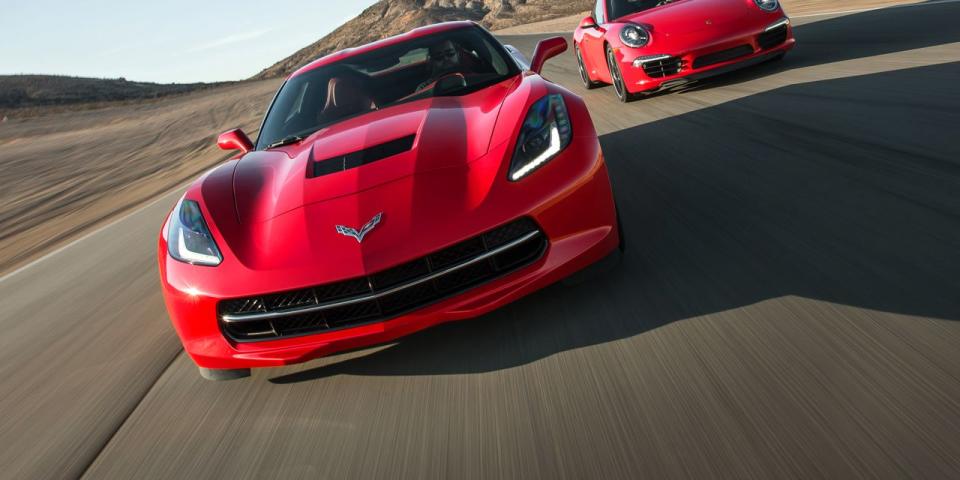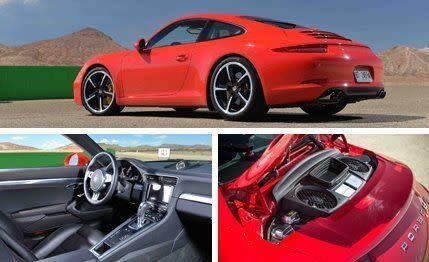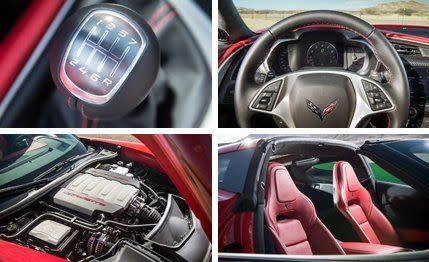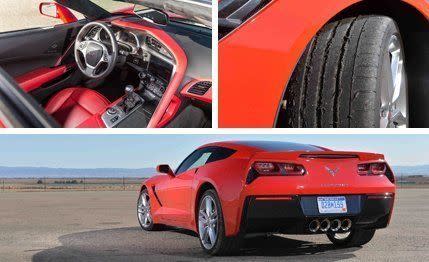2014 Chevrolet Corvette Stingray Z51 vs. 2014 Porsche 911 Carrera S

From the November 2013 Issue of Car and Driver
TESTED
Real longevity is rare in the automotive industry. Only a handful of models have made it to the half-century mark, but the milestone the Porsche 911 celebrates this year is one the Corvette passed a decade ago. Both have survived rampant model proliferation that has crowded their markets, plus rumors of massive, personality-altering redesigns, as well as the suffocating and ever-changing regulation inherent in one of the most scrutinized consumer-goods industries in the world.
But here are the 2014 models, two old masters that have provided much more than mere transportation in their long, storied histories. And both are recently renewed, creating the perfect occasion for critical analysis.
When lined up against a Corvette, the 911’s major drawbacks have always been power and price. With direct injection and a 7600-rpm redline, the Carrera S’s 3.8-liter flat-six produces 400 horsepower, a substantial 60 shy of the Corvette. And oh, that price! Atop a base of $99,850, the example tested here carries $48,395 in extras—including six items that cost more than $3000 apiece, plus an additional six that are more than $1000 each. This car’s options bill alone is nearly enough to buy you a base Corvette.
Which would cost just $51,995. But this one is armored to pick fights with Porsches. It has the $2800 Z51 handling package (upgraded brakes, shocks, springs, anti-roll bars, wheels, and tires; plus dry-sump oiling and an electronic limited-slip differential with coolers for both it and the transaxle); the $1195 performance exhaust (an extra five horsepower and five pound-feet with angrier vocals); and the top-shelf 3LT interior package for $8005, in which pretty much everything is power adjustable, heated, and leather wrapped. There are a few other extras, too. Even at an as-tested $68,375, the Corvette retains its value proposition. But our prior exposure to the C7 suggests this may finally be a Corvette that doesn’t rely on price alone to conquer the 911.
Lying roughly equidistant from nowhere you’d want to be and nowhere you’re particularly likely to find yourself, Lockwood Valley Road in Southern California looks like what would happen if someone paved a road over the ocean during a typhoon. With rapid-fire corners and more ups and downs than a Nicholas Sparks script, it’s an entertaining stretch. But its rough, bone-rattling surface is what really lets a driver know what’s up. Important insights such as: “Hey, maybe I need a kidney belt to own this car.” Or, more pertinent here: “That 911 doesn’t lose its cool while being pummeled.” Even when bumps, pits, and what must be asphalt-entombed desert tortoises try to fling the wheels off the pavement, with the engine alternatively zinging and bogging like a jet ski in rough chop, there are no uncertain moments in the 911.
It remains a sensationally involving car, even with steering that is marginally less precise than the Corvette’s. Perfectly linear, the Porsche responds predictably to every input, changing direction immediately, rotating as requested by throttle lift, drifting at the behest of the brakes, and settling immediately when you get back on the gas. There’s just a hint of the old 911’s arse-swapping spook as the immediacy of the directional changes reminds you of the engine’s placement. After all, the car carries nearly two pounds in the caboose for every one in the nose, but it’s a defanged threat nowadays. The 911 is an eminently controllable, responsive vehicle that encourages its pilot to use every bit of its performance.

The 911’s noise also connects the driver to the machine. It’s a softer, silkier burr than the Corvette’s roar, but the noises that do make it through are more vivid, particularly as the flat-six howls toward its 7600-rpm redline. Porsche’s six suffers a deficit of 140 pound-feet to the Chevy V-8. But, thanks to the PDK’s finger-snap shifts and a slightly more advantageous seven-speed gear-ratio spread—the Porsche hits top speed in sixth, the Chevy in fifth—the 911 manages to outaccelerate the Vette by a tenth of a second in the quarter-mile.
The 911 also trumps the Vette in interior space. In the Vette, you sit deep in a well between the center console and the door panel, which closes in so tightly that we had difficulty reaching the seat controls. Both of our voters preferred the 911’s airy interior to the Vette’s cramped cockpit. Indeed, our drivers preferred the 911 in virtually every regard and agreed that it is more fun than the Vette. With a price more than double that of the Chevy, though, the 911 had damn well better be the better car. But the new Corvette takes such a large leap forward that the 911 would need to be even more entertaining than it is, and seem even more special, to feel worth it.

With its outrageous styling and bawdy exhaust note, the Corvette is pure performance art. It’s new and it’s impossible to ignore, so the 911 simply disappears in its presence. At every stop, the Corvette was swamped with people taking pictures, asking questions, and simply standing in awe. The 911 sulked. Many people thought the Chevy looked like a Ferrari. The 911 looks like the last 911, or maybe the next one. Sure, fame is fleeting. Give it a year, you say, when the Corvette will be as common as a bellybutton. But like a pierced one, the C7 will still be impossible to ignore.
Inside, the Corvette won’t be mistaken for a Ferrari or a Porsche. Everything from the red-leather seats and dashtop to the carbon-fiber trim and the secondary controls is a class above those in the outgoing car. Still, the Corvette suffers a few tells that it’s still merely posing as a six-figure supercar. The gap between door panel and dash is big enough to swallow a roll of nickels, and the entire door panel flexes when you press the unlock button. On our preproduction car, a coolant-return line came free of its moorings, rubbed on the alternator pulley, and misted the engine compartment with a gallon or so of Dex-Cool. The noisemaker got hot really fast after that.
Door panels, though, are the only parts of the Corvette that flex. Its basic structure approximates the solidity of granite, and while the electronic power assist electrocutes any steering feel that might have existed, the immediate and progressive helm gives the car true response and precision. It demands total focus at all times, however, as the smallest off-center input results in directional change.

Worn tires and a hot track meant we couldn’t replicate the skidpad figure of 1.08 g from our first Vette encounter [September 2013]. And the Chevy trailed the 911 through the slalom, though the times don’t reflect how much more stable the Corvette feels at the limit. Scary breakaway behavior was one criticism of the last Vette Z06, but this Vette is supernaturally accommodating of adjustments, mistakes, and corrections at speed. Its center-of-gravity height—17.5 inches—is the lowest we’ve yet measured, contributing to a resolute stability. And its electronic differential helps keep the C7 glued to a chosen line. The Corvette lapped the Streets of Willow Springs racetrack in Rosamond, California, 2.1 seconds quicker than the 911, a tremendous gap on a track just 1.6 miles long. But on a circuit, the Corvette’s relative nonchalance marginalizes the driver. The 911 responds to every little input. It squirms and rotates, and it’s easy to make it do so. The Corvette is so planted that it feels less like you’re controlling the car and more like you’re simply steering, using the wheel to point it where you want it to be and the accelerator to get it there. The higher fidelity of its steering broadcasts the lower fidelity of its chassis.
As with the 911, its engine has always defined the Corvette. The new LT1 sports several fresh technologies—variable valve timing, direct injection, and cylinder deactivation—but it still shakes the whole car at idle as you’d expect. The 911’s power builds with a couple of pronounced steps through the rev range. The LT1, in contrast, feels like it’s at its power peak at any rpm, all while sounding like test day at Talladega. If you stay out of the gas long enough in Eco mode, the engine will operate as a V-4. In this mode, we saw an indicated 35.8 mpg over 25 miles of dead-flat California desert. From our observed fuel economy, though, you’ll notice that we didn’t do enough of that to make a difference.

Helping the Vette achieve that economy, as well as its ever-so-slight rearward weight bias, is its mid-mounted manual transaxle. With seven speeds and automatic rev matching, it’s ready for a spec-sheet showdown with anything else in the business. But, while its fore-aft action is clean and direct, there are a lot of gates here with insufficient resistance between them. It requires a slow, deliberate hand, and we frequently missed upshifts coming from second or fourth into the gearbox’s muddy northeast quadrant. Porsche’s seven-speed manual has a lockout that prevents shifting into seventh except from fifth or sixth. That, too, can be annoying—think about how many times you shift out of high gear in freeway traffic, and now imagine that getting back into high gear is a two-step process—but maybe the two-part shift is the better solution after all.
Before you start howling that the Corvette won solely on price, notice that in the stuff that really matters to sports-car buyers, chassis and powertrain, the Porsche holds a single-point lead. Is such a minute edge worth $50,000? $80,000? The Corvette doesn’t win on dollars. It wins on sense.


You Might Also Like

 Yahoo Autos
Yahoo Autos 